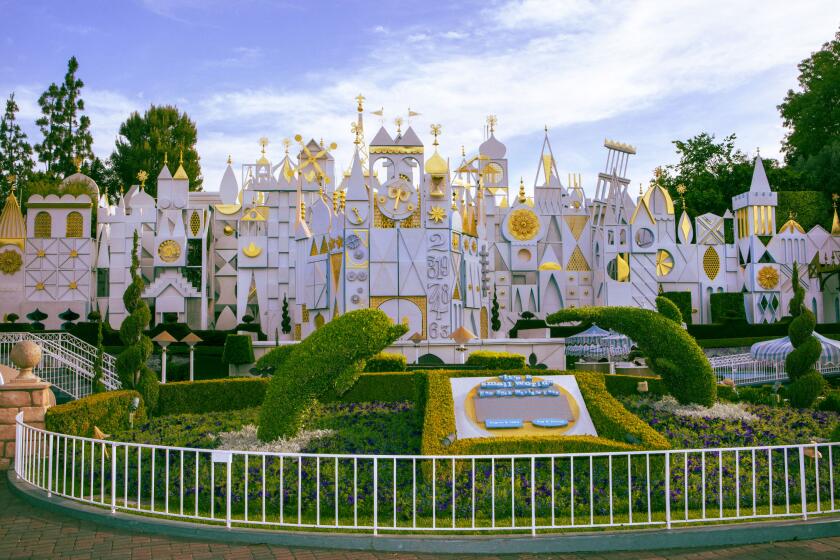Latino immigrants proud that L.A.’s next archbishop is ‘one of us’
- Share via
It was a weekday evening following the exhilaration of Holy Week, but St. Michael Catholic Church in South Los Angeles was still abuzz.
There was a memorial Mass for a deceased parishioner, a spiritual encounter for couples, a women’s prayer gathering and a session for new parents -- all conducted in Spanish. People arrived en masse as though headed to a sporting event, undeterred by a church bulletin noting five recent homicides in the vicinity.
Word was just circulating that the Archdiocese of Los Angeles would soon have a new leader -- Archbishop Jose Gomez of San Antonio, Mexican-born, like most of these parishioners -- replacing Cardinal Roger Mahony, set to retire next year after a quarter-century guiding his hometown see.
A pervasive sense of pride, even elation, greeted the news that a compatriot would become the heir apparent.
“Of course it makes you feel good. He’s one of us; he understands us,” said Juan Bramusco, 60, originally from Mexico’s Zacatecas state.
Many agreed that such an appointment was long overdue in an archdiocese that is now 70% Latino. But Humberto Magallanes, another volunteer, voiced a common refrain.
“The new bishop is going to have some big shoes to fill,” said Magallanes, 29, a construction worker. “Cardinal Rogelio Mahony has fought for immigrants as much as anyone.”
The scene, in miniature, captured much of the mood in Latino-dominated Catholic churches in Southern California as the leadership transition began to unfold in the nation’s most populous archdiocese.
The appointment of Gomez, poised to become the country’s highest-ranking Latino cleric, represents a watershed changing of the guard in the U.S. church, which is headed toward a Latino majority in coming years.
“It’s a recognition of the numbers, basically,” said a delighted Msgr. David O’Connell, pastor of St. Michael, as he directed parishioners to the various events Tuesday evening.
The sex-abuse scandals that have battered the church’s global image don’t seem to have deflated attendance at St. Michael and other Southern California parishes brimming with new Latino immigrants championed by Mahony and his like-minded priests.
“There’s a real contrast for us these days between what’s happening in these parishes and what’s happening in the church at large with all the scandals,” said O’Connell, a white-haired native of Ireland who has served more than three decades in Southern California. “The church is having a difficult time. But at the parish level we are experiencing this whole new vitality and energy.”
Many parishioners spoke of a sense of belonging in a world that can often feel threatening, especially for those in the country illegally, as is the case for many at St. Michael.
“In Latin America, we rely on a sense of family, but this country can be very cold sometimes, intimidating,” said Leopoldo Rivas, 36, who was attending a meeting for married couples at St. Michael with his wife, Beatriz. “Here at the church we feel we are part of a family.”
The acclaim for Gomez’s appointment at St. Michael and other Latino-dominated churches was clearly not a case of relief at the departure of an old regime. Quite the contrary.
Parishioners seemed to have nothing but praise for Mahony and his immigrant-friendly agenda. His Spanish may be heavily accented, several said, but all had seen the tall, bespectacled figure taking their side on Spanish-language television. Many seem to connect the church’s pro-immigrant stance to their comfort level here.
The feeling of belonging has resulted in a striking sense of dynamism and solidarity at many Latino-dominated Catholic churches, especially at the Spanish-language services that now typically outnumber, and outdraw, the English-language ceremonies.
The immigrant boom has revitalized houses of worship like St. Michael that seemed doomed a generation ago as older congregations moved out or lost interest.
“A number of churches founded in the early 20th century in the core areas of Los Angeles that were left near empty as a result of migration to the suburbs filled up again with the immigration that began in the 1980s,” said Tod Tamberg, an archdiocesan spokesman.
Two decades ago, the evenings would typically find St. Michael empty and the parking lot vacant. “The priest’s car was the only one parked here at night,” said Juan Bramusco, who was among a trio of volunteers providing security for a packed lot on a recent evening. “Now we hardly have space for everyone.”
The Virgin of Guadalupe, the transcendent standard-bearer of Mexican Catholicism, has become a ubiquitous symbol whose feast day is celebrated with mariachis even at wealthy St. Monica Catholic Church in Santa Monica, where Gov. Arnold Schwarzenegger and his family worship.
Many expert commentators expressed concern that Gomez could bring a more conservative vision to a church where Mahony has long been viewed as a progressive proponent of the 1960s-era Vatican II reforms that liberalized Catholic practices. That remains to be seen.
But Gomez, in his introductory statements, left no doubt that Mahony’s championing of immigrants would be at the top of his agenda. That message came through loud and clear among the new-immigrant multitudes who have brought new life to venerable churches like St. Michael, founded more than a century ago by German dairy farmers.
“Cardinal Mahony was always a great friend of immigrants,” Jose Garcia, 72, a native of Mexico and longtime member of St. Thomas the Apostle, said Wednesday outside the Pico-Union church. “The new bishop is Latino. He can communicate with us directly. We can only hope that the politicians will listen to him.”
More to Read
Sign up for Essential California
The most important California stories and recommendations in your inbox every morning.
You may occasionally receive promotional content from the Los Angeles Times.










